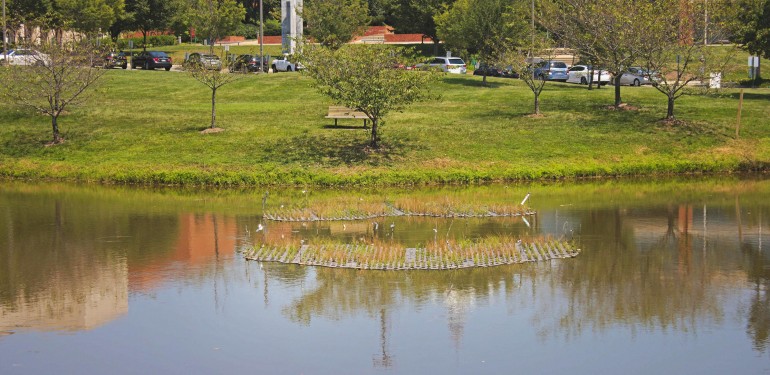Photo credit: Claire Cecil
Last May an environmental science professor and his students installed floating wetlands in Mason Pond.
Changwoo Ahn, associate professor of environmental science and policy, and students in his ecological conservation course built a structure totaling 180 square meters that covers about 2.5 percent of the pond and contains about 1,500 native plants, says junior Andy Sachs who participated in the project.
The wetlands were constructed by placing individual plants within a raft that could be released into the pond to help improve water quality. Planning lasted for a year and a half, but most of the design and building was completed last spring.
“We’re trying to bring a living ecology to the pond that had grown sedimentary over the years,” Ahn said.
Ahn is also the founder of EcoScience+Art, whose website describes itself as “an initiative and collaboration between the arts and sciences at George Mason University,” whose goal is to unite people across a variety of fields to create a sustainable future.
The Rain Project is part of this initiative. It aims to provide an aesthetic view of healthy water ecology, create a sustainable habitat for animals and insects, and clean the water within Mason Pond, according to Ahn. The wetlands were an undertaking of the Rain Project.
The wetlands clean the water in the pond by drawing in pollutants through the plants’ roots, which extend into the water from the raft. However, Ahn said that due to restrictions from the facilities department, the ecosystem is too small to extract a significant amount of pollutants.
“I originally wanted to go much bigger, to make it work and improve water quality. People cannot really expect a high amount of water quality improvement. With that size, it’s not really going to happen,” Ahn stated.
Twenty students from various departments at Mason pitched in to construct the wetlands, thereby accomplishing a chief goal of the Rain Project: interdisciplinary environmentalism.
“The most important part [of this project] is the fact that students from all different disciplines have come together for over two semesters to design, build and launch the floating wetlands on Mason Pond,” Ahn said.
Sachs, an integrative studies major, first learned about the project through a member of the Sustainability LLC, where Sachs was living, in the fall of 2014. After meeting with Ahn and discussing the project, which was then in its early stages, Sachs joined. He also registered for Ahn’s ecological sustainability class, a two-semester course that focused on the wetlands. While the fall semester of Ahn’s course emphasized learning about ecological sustainability and interpreting data, the spring semester focused on the construction of the wetlands.
“During the spring of 2015, Dr. Ahn’s ecological sustainability course was geared towards researching and constructing these wetlands,” Sachs said.
Sachs said students compiled a list of the steps needed to construct the wetlands and broke into separate groups to complete each task. These groups then developed and presented their own designs for the wetlands. After a single design was chosen, the students collaborated to build the wetlands.
Sachs, who is pursuing a career in environmental policy and outreach, says that the project fed this interest and taught him “crucial scientific research skills.”
“The Rain Project was designed to build on past research of floating treatment wetlands (FTWs) with a full-scale, artistic installation, and to bring awareness to ecological issues,” Sachs said.
The wetlands were launched on May 12, 2015, at a day-long event run by approximately 20 volunteers. Local K-12 students attended the launch to learn about the project and the research process, according to Sachs. Local news station NBC Washington also featured a story about the wetlands.
While Ahn says the students collaborated well, he also admits the process was not without its arguments. The wetlands project brought together students from both science and arts backgrounds, which sparked “heated discussions” at times.
“Another dimension of this project is enhancing communications among the students from all different departments. If students can do this, then faculty members across all departments can do this. We tend to stay in our own departments, our own comfort zones…Where the wonder is, is out of your comfort zone, that’s where you can find the solutions for many of the problems we’re facing,” Ahn said.
One obstacle the students faced was the burning of the Temple of Transformation, a wooden pagoda built by a Mason student as part of an art project, last semester. After the temple, which stood on a small raft near the edge of the pond, was burned on May 8 in a ceremonial healing ritual, the water in Mason Pond was very oily, according to Ahn.
Students met up over the summer to monitor the water quality and record several lectures about the floating wetlands. As far as the future of the wetlands is concerned, Ahn recently recruited more undergraduates to join the later part of the project, which will begin after the fall 2015 semester. The new project involves harvesting the plants from the wetlands to study the amounts of carbon and nitrogen in their tissues.
“I am planning a photobook or e-publication type of work on all the student learning experiences of the Rain Project,” Ahn said.
There will also be a seminar at Mason on November 12, where environmental artist Betsy Damon will speak about Keepers of the Water, a company that aims to alleviate water issues through “collaborative innovative design, community organizing, mentoring, educating, providing workshops, and functioning as a cross cultural resource,” according to the website.
Ahn said he believes people need to be reminded of the importance of water.
“We just have to get reminded daily that we are water, we drink water…the human heart is 4 percent muscle, and the rest is water,” Ahn said. “That’s the message that I wanted to share, the work of the RainProject.”




